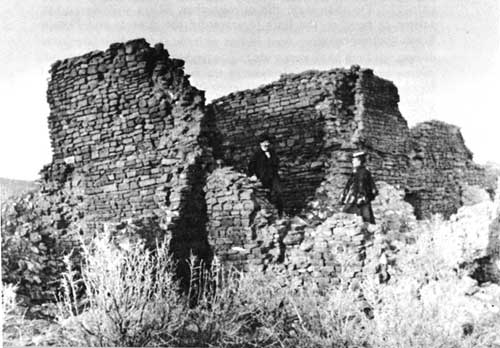|
AZTEC RUINS National Monument |
 |

Aztec Ruins in 1895.
Explorations and Excavations
Despite popular opinion, and despite the name applied to the ruins, the Indians who built this ancient pueblo were not related to the war-like Aztecs of Mexico. In the late 1800's, there was considerable interest in the seemingly mysterious Aztec, Toltecs, and other Indians of Mexico. The writings of Stephens, Prescott and others had fired imaginations, and new communities—particularly those in the vicinity of Indian ruins—were often given names of Indian groups from south of the border.
So it was with the town of Aztec. When white settlers first moved into the Animas Valley, they were intrigued by the great stone ruins. Believing them to be the work of a long-vanished race from the south, they named their town Aztec.
The ruins, in turn, became known as "those ruins at Aztec" or simply as "the Aztec ruins," and so the name remains today. We know now that the Aztecs of Mexico, whom Cortez conquered, had nothing to do with these ruins. In fact, they were built and abandoned several centuries before Cortez, and even before the Aztecs themselves were well established in the Valley of Mexico.
The earliest reference to ruins along the Animas River in the vicinity of Aztec is found on the map of Escalante's Expedition in 1776-77. On that map, the cartographer, Miera y Pacheco, has written in between the lines representing the Animas and Florida Rivers the following:
The branches of these two rivers are capable of being inhabited by very large populations as is shown by the ruins of very ancient towns.
It is doubtful that Escalante or any of his party actually saw the Aztec ruins themselves, since the map would indicate that they were well north of that particular spot, probably somewhere in the vicinity of the present-day Durango. Further, the Escalante map shows the Rio Florida as flowing directly into the San Juan where actually it flows into the Animas. Likewise, it shows what are now known as the La Plata and Mancos Rivers as flowing into the Animas whereas they flow directly into the San Juan. If any of the Escalante party had followed these streams or the Animas to their junction with the San Juan, these mistakes would not have been made on the map, so the party must, therefore, have been well north of what is now Aztec.
Possibly other earlier explorers may have passed near, or by, the Aztec ruins, but the next recorded visit occurred on August 4, 1859, when Dr. John Strong Newberry visited the site. Newberry, like many of the 19th-century men of science, was a man of many talents. He graduated from Western Reserve University in 1846, then obtained a degree in medicine, and later studied geology in Paris. At one time or another he was associated with the Smithsonian Institution and also taught geology at Columbian (now George Washington) University. In 1859, he accompanied Capt. T. N. Macomb (a topographical engineer) on an exploring trip from Santa Fe to the junction of the Grand (now upper reaches of the Colorado River) and Green Rivers where they formed the Colorado River. The following paragraph about the Aztec ruins is taken from his account of this trip:
The principal structures are large pueblos handsomely built of stone, and in a pretty good state of preservation. The external walls are composed of yellow Cretaceous sandstone, dressed to a common smooth surface without hammer-marks; in some places they are still 25 feet in height. As usual in buildings of this kind, the walls were unbroken by door or window to a height of 15 feet above the foundation. The interior shows a great number of small rooms, many of which are in a perfect state of preservation, and handsomely plastered. These structures are surrounded by mounds and fragments of masonry, marking the sites of great numbers of subordinate buildings; the whole affording conclusive evidence that a large population once had its home here.
White settlement of the valley around the ruins area began in 1876, and from that time on the ruins have been well known.

|

|
|
Last Modified: Sat, Jan 13 2001 10:00:00 am PDT |


